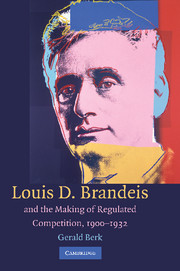Book contents
- Frontmatter
- Contents
- Figures and Tables
- Acknowledgments
- 1 Creative Syncretism
- PART I BRANDEIS AND THE THEORY OF REGULATED COMPETITION
- 2 Republican Experimentalism and Regulated Competition
- 3 Learning from Railroad Regulation
- 4 The Origins of an Ambiguous Federal Trade Commission
- PART II REGULATED COMPETITION IN PRACTICE
- PART III REGULATED COMPETITION CONTESTED
- PART IV CONCLUSION
- Appendix Industries and Number of Associations with at Least Substantial Involvement in Developmental Association, by Industry Group
- Index
4 - The Origins of an Ambiguous Federal Trade Commission
Published online by Cambridge University Press: 23 November 2009
- Frontmatter
- Contents
- Figures and Tables
- Acknowledgments
- 1 Creative Syncretism
- PART I BRANDEIS AND THE THEORY OF REGULATED COMPETITION
- 2 Republican Experimentalism and Regulated Competition
- 3 Learning from Railroad Regulation
- 4 The Origins of an Ambiguous Federal Trade Commission
- PART II REGULATED COMPETITION IN PRACTICE
- PART III REGULATED COMPETITION CONTESTED
- PART IV CONCLUSION
- Appendix Industries and Number of Associations with at Least Substantial Involvement in Developmental Association, by Industry Group
- Index
Summary
On September 26, 1914, President Wilson signed the Federal Trade Commission Act into law. Not long before, it looked as though antitrust reform was dead, because populist Democrats and progressive Republicans disagreed over the commission's ends and its powers. But creative entrepreneurs in Congress overcame the conflict through legislative syncretism. They transcended the debate between a weak and a strong commission by introducing Brandeis's cultivational option. They combined failed Democratic and Republican proposals by turning progressive instruments to populist ends. And they created a majority coalition in favor of the statute by crafting a law with multiple meanings. Section 5 declared unfair competition illegal and licensed the commission to issue cease-and-desist orders against it. For Brandeisians and populists, this meant the FTC was empowered to prevent monopoly and set the nation back on the path to republican equality. For progressives, it meant the commission was empowered to countervail economic power and cut a new path from drift to mastery. Thus, the statute passed not because it was clear victory for anyone, a mere compromise, or a “common carrier” that served multiple interests. The Federal Trade Commission Act passed because it had quite specific, yet different, meanings for its supporters.
This chapter recounts a constructivist history of the Federal Trade Commission Act, which shows how its path to success generated more possibilities and involved more creativity, deliberation, and storytelling than is usually recognized.
- Type
- Chapter
- Information
- Publisher: Cambridge University PressPrint publication year: 2009



